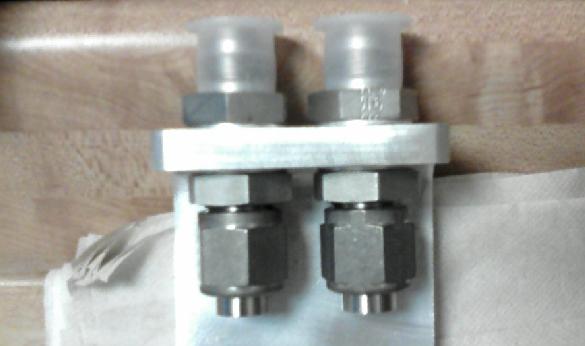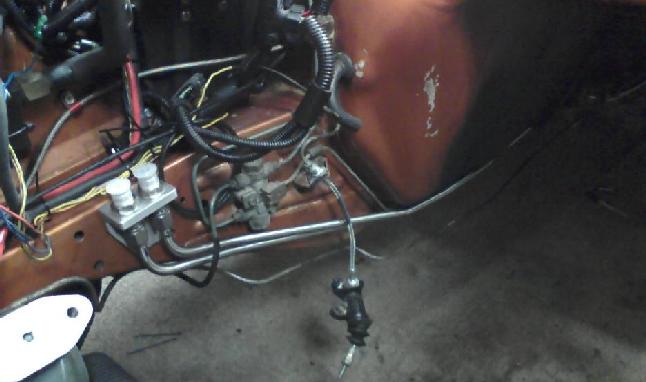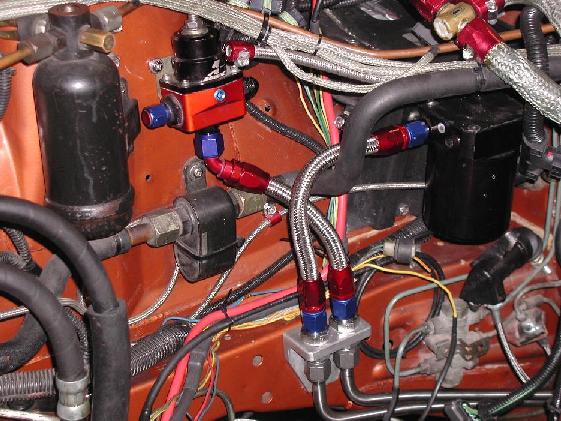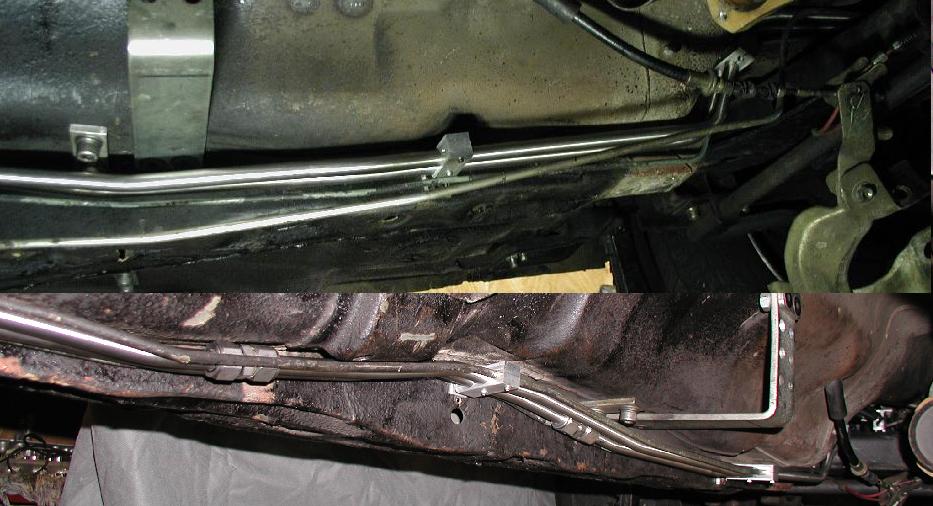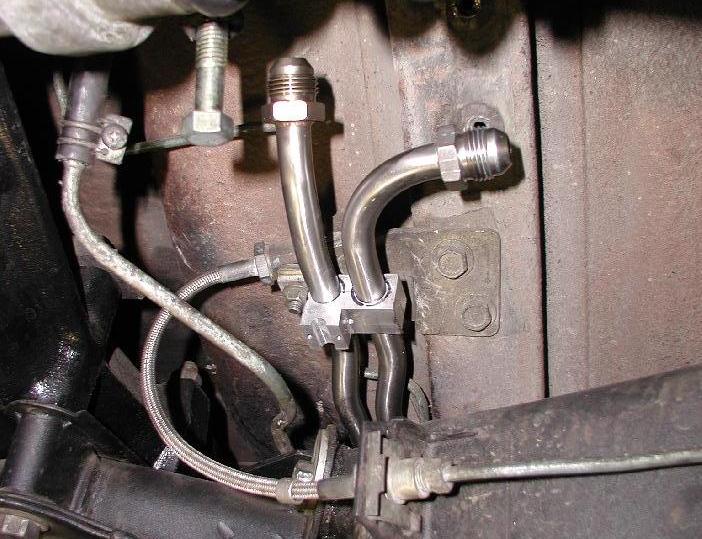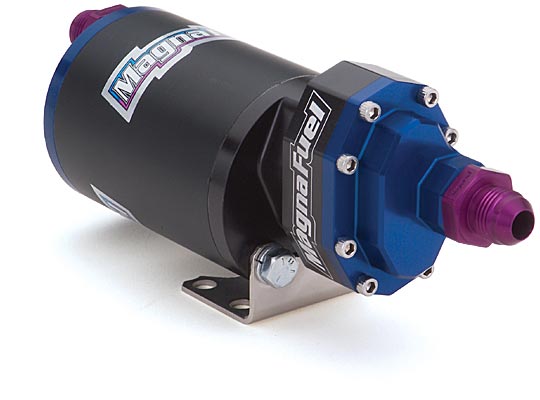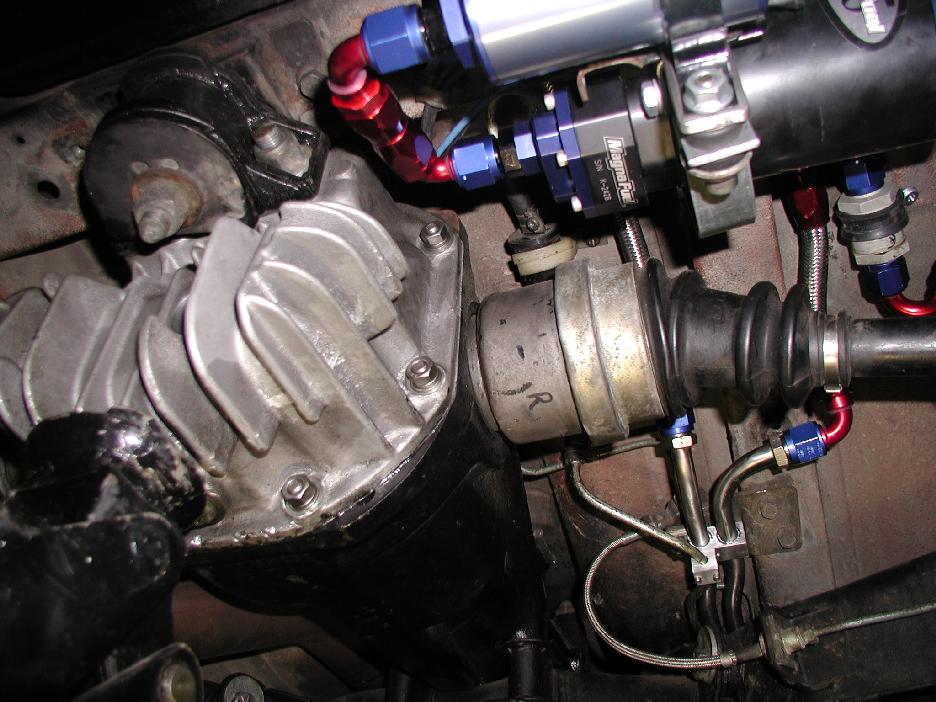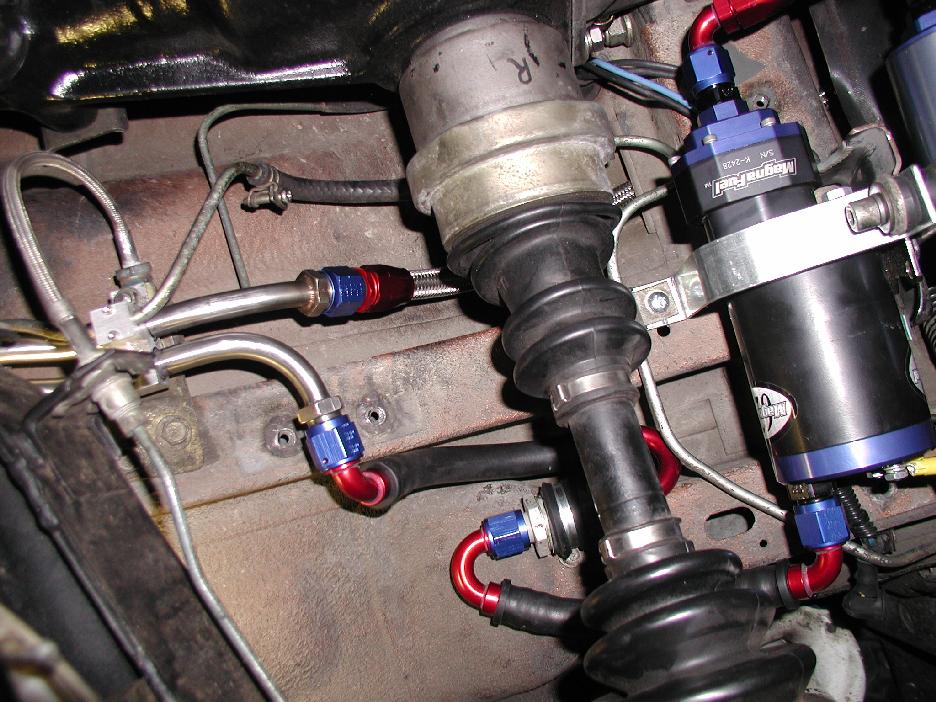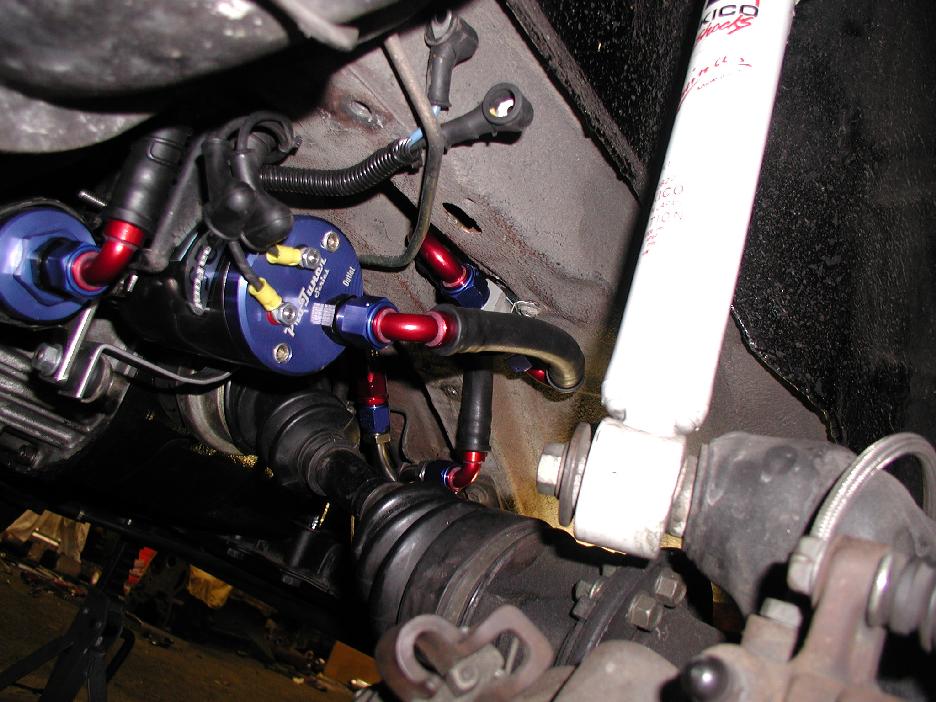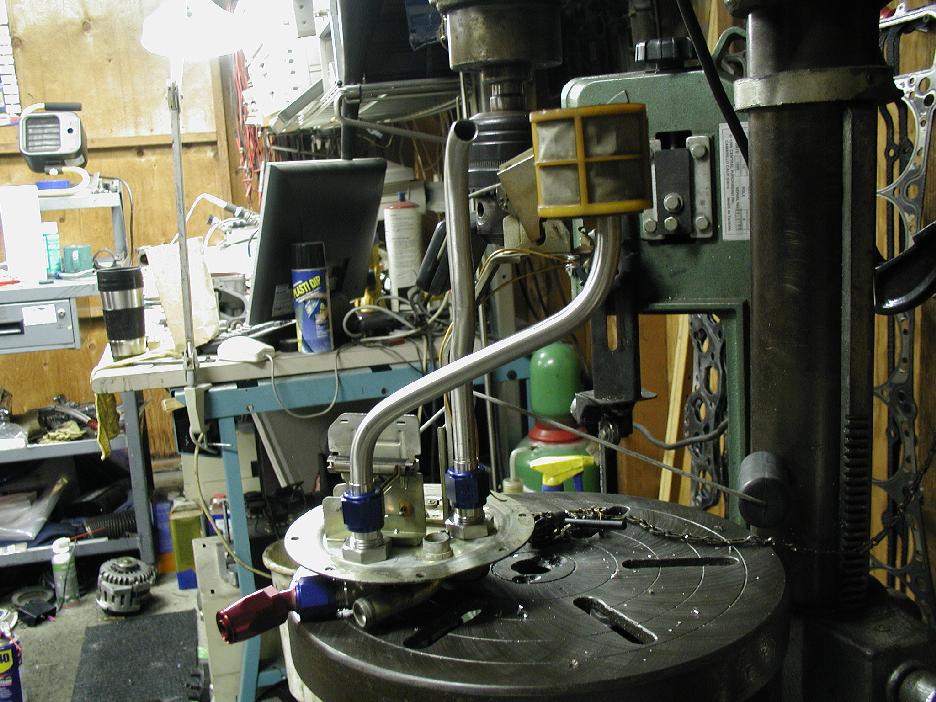Fuel Delivery
There are a number of fuel pressure regulators on the market, some good, some bad, some good looking, some not so good looking. Here are pictures of an Aeromotive unit on the left, and an SX unit on the right. I use the Aeromotive unit because it is cheaper. Both units are excellent quality and operate to the same high level of standards. The Aeromotive unit runs about 25.00 cheaper then the SX unit. Note that both units require the use of AN fittings, the Aeromotive unit is setup to utilize the -10 connector fittings and the SX unit is setup to utilize the -6 fittings.
Both units are rising rate regulators, a 1 to 1 rate. I tested the Aeromotive unit and it is about .95 to 1 rate and that is good enough for me.
The primary consideration on the size hose and connector is the amount of fuel need to deliver sufficient fuel to the engine at WOT. You will need to vearify the complete system to ensure the correct flow rate and maximum fuel pressure based on the injector size and the application, I.e. turbo, N/A, or super charged.
You can calculate the flow rate by summing all of the injector flow rates to come up with the total system requirements with the injectors running at 100% duty cycle. Once you have drtermined the total flow rate, you need to determine the pressure requirements of the system. My car is a turbo setup so to find the correct flow rate at the correct pressure you start with the base pressure, in most cases 3 bar or 44.1 psi,(less with the engine vacuum while running) then you add the additional pressure the turbo will develop, in my case 25psi of turbo pressure. Now we have 44.1 psi plus 25psi for a total of 69.1 psi. To test the system delivery, you then would set static pressure to 44.1psi apply the 25psi of pressure to the regulator and start the pump. The flow rate required for six 500cc/Ml injectors would be 3000cc's/ml per minute. Disconnect the return line and run it into a measuring container and run the pump for one minute. Take the measurement and you should have at least 3000cc's/ML to be able to provied enough fuel at WOT. This is the very most the system will flow through the injectors at 100% duty cycle. It is useful to realize most systems will not run the injectors at 100% duty cycle, but you need to have the head way designed into the system, and there are systems out there that are getting to 100% duty cycle of the injectors. I have a Jim Wolf setup that does run 100% duty cycle at WOT.
NOTE: when you test the system, keep in mind that when the vehicle is running, the supply voltage to the fuel pump will be 13.8 volts. I realize this in most cases will not matter, but when you get into running a system and pump to is't maximum flow rate like my car, the voltage change at the pump is significant. I tested my system at 12.6 volts, there is a .4 volt drop from the fuel pump relay to the pump, the system flowed 3000 cc's/ML. I then put my battery charger on the battery and brought the voltage up to 13.6 volts and the pump was seeing 13.2 volts and the pump flowed 3300cc's/ML of fuel. Just something to keep in mind, because the last consideration for your delivery system is its ability to return fuel to the tank. So if you have a great delivery and a bottle neck in the return, you will not be able to run the minimum fuel pressure at for instance, negative manifold pressure at idle. If you cant return the fuel to the tank correctly, then you run into a situation of excessive pressure at idle which will make the car run rich at idle. The really radical 4 cylinder cars have this challenge, becaues the injectors are so large to get the Hp from the engine. You stop to consider a four cylinder car running 4 720cc/ML injectors and at 750RPM, you really need to shut down the duty cycle to get the engine running correctly and not be throwing raw fuel out the tail pipe. You get what I am saying right.
So make sure the mechanical part of the system will do exactly what your application is and then go for the electronics, because that is a challenge all in itself, and if you dont think so ask some guys who tune DFI, TECHII, type systems.
I have noted that both units will leak down fuel pressure after about 12 hours. This is not a issue if the fuel pump runs for abour 5 seconds before the engine is turned over. The only thing you will find is hard starting if you do not pressureize the system before trying to start the car, however, for the most part the leak down is a non issue for most applications.
I was at one time having starting problems with my stock system because the rubber check valve in my fuel pump got hard and really drained the system. I will also add that there was not an air issue I was dealing with, but a rise time on the fuel pressure of the system because of the defective check valve. There is a good article on IZCC regarding the fuel pressure you may want to check out and read also.
My final suggestion for selecting a pump and the accessories for the system is ask questions, try to find a guy running a similar system and get accurate information. I found that a number of shops that sell pumps, regulators, and all that, really cant answer definetly a question about flow rates, hose size and the best setup. I spent about 350.00 of wasted money on parts for my system that would not do what I need them to to for a variety of reasons, and I still am not to happy about that. I did ask the hard questions and got wrong answers, so if you dont know, make darn sure of what you are buying and that it will fufill the system requirements for your particular application. Guess work in this area can cost hundreds of dollars for a wrong, say pump selection.These components get very expensive when you need some real flow for performance applications.
I have been wanting to do the fuel delivery upgrade for some time. I have spent numerious hours tweeking changing pumps, flow testing the system and there was always some doubt as to how well it would work over the long haul. Well it seems I was working the fuel pump to hard to get the flow numbers at the required pressure. I did not want to spend a bunch of money on a fuel pump in the beginning, but as the years have passed, I have already spent about $800.00 for various pumps to get what I needed.
I decided to go for it and do the lines and go to 1/2" line to make sure there was enough capacity. I don't want to worry about the system anymore.
Here is a picture of the finished line. I must say this was as difficult as the exhaust system I fabricated. The lines are two pieces. I decided a union would make servicing easier. I was able to install the lines complete, but the engine was removed. I don't think it is removable with the engine installed.
The lines are made of 1/2" 316L stainless steel seamless tubing. I bought two 20 foot lengths to start and ended up using about 20 feet total. I messed up about 20 feet of tube trying to bend it correctly. The tubing was about $135.00 a stick, so it is not cheap, BUT.
I was first going to have the tube made from a company in Michigan, Classic Tube. I cut my lines in half and sent the lines to them to make in 1/2" stainless. They first lost my lines for about two weeks, I hate it when when people at companies keep asking me my name and what I sent to them, clear sign they had no idea of what they were sent. I send along with the stock lines what I wanted for the new lines. They said they could not get 316 stainless, could not get seamless tubing, and after all of the waiting, when I did get my quote, they quoted me for 3/8" line, exactly what I sent them. I had the lines sent back to me and found another shop locally in huntington Beach. I was quoted $1000.00 to do the lines. Well after their quote I decided to bite the bullet again and do the work myself. I was trying to save a little time and head-aches but again I have ended up doing all the work myself, OH WELL!
So I bent my own lines, and it took me a little of working with the bender and tubing to get what I wanted without it looking like god knows what.
The lines are not perfect, but as you can see from the picture they look pretty good. I also had to make a new set of brackets, so I decided aluminum brackets were the easiest and quickest way to go. The brackets turned out very well, but the hard part was to make two 1/2" lines fit the 1/2" holes in the brackets correctly so they would clamp properly. That was the big challenge,getting the lines to fit the car, and fit the brackets and bolt up well.
Here are some pictures of the line installed, I think they turned out very well if I do say so myself.
The inlet and outlet bracket was made out of aluminum angle extrude, very strong. My wife made the comment is it strong, and all I could think of is that it would survive a plane crash LOL.
The installed part has moved back from the stock location, and because I could make all of the bends like the stock line, I ran it to the inlet outlet block a little more streamline. I did first try to do all of the bends under the frame rail and all that, and it was close, but not good enough for me to want to install.
Here are the lines fully plumbed in and ready to go. I am still using the same Aeromotive fuel pressure regulator. I may have to upgrade, as the return outlet of the regulator is really made for a 3/8" line or -6 line. I bought an adapter that transitioned to the 1/2" or -8 line. I will have to test the system to make sure I have enough return flow for the new fuel pump. Aeromotive makes another regulator that will work just fine, but I will test the system first. I am tired of spending money on this stuff LOL.
Here is a picture of the lines down the length of the car. I think it turned out very good. I was beginning to have my doubts about this install, tubing is not my most favorite engineering task.
I did not want all of the extra hardware to make the connections at the tank, so I bought -8 female unions and machined them to fit the line. I then had them TIG welded to the line. Here is a picture of the line installed and terminated with the fittings. I was able to maintain the stock location with my new bracket.
They turned out good, but I have to admit, there are a couple bending kinks in the line from the bender clamp, 316L is very hard and doesn't like to bend all that well, so again, getting use to how to utilize the bender made all the difference in the world, it just has its quirks, but once you learn how to get a good bend it is all down hill, YEA RIGHT!
Here is the pump I got for the job, Magnafuel makes this unit and it is a little beef monster. The pump can provide up to 130 PSI line pressure, so dead heading the pump is not to good to do.The flow rate 2.5 gallons per minute, so you can see the system is designed to circulate some fuel!.
ProTuner Series Engine Hp: up to 2,000+¹ Once-piece design is more compact and light weight.
Ideal for street muscle cars.
Quiet operation.
Self priming.
Continious duty.
No pump shaft seals, no leaks.
Pump body CNC machined aircraft aluminum.
High-torque custom motor with very low current draw.
Never requires stepdown.
More efficient than other motors.
Double support bearings.
Rebuildable to as-new condition.
Compact design fits in smaller spaces.
Smaller than competive pumps, lower current draw, more powerful.
Hard anodized, long lasting finish.
Mounting bracket included.
Vertical or horizontal mount.
Polymer wear plates for smooth, quier operatio.
Model No. Horsepower¹ Pressure Amps@12.5V Ports²
MP-4303 2,000+ 20–120psi 14A@45psi #8AN in and out 7"L x 3"Dia 4.5 lbs.
MP-4301 1,500+ 20–120psi 12A@45psi #8AN in and out 7"L x 3"Dia. 4.5 lbs.
MP-4302 1,000+ 20–120psi 10A@45psi #8AN in and out 7"L x 3"Dia 4.5lbs.
My testing of the system revealed the pump current to be 15 Amps with 75-80 psi of line pressure. A little higher then advertised, but not to bad. The pump was drawing about 11.8 Amps at 43 psi of line pressure. So what this tells me is that the car is using this much current at idle. I cant emphesize more strongly to CHECK the available current draw from the electrical system at idle to make SURE the alternator is up to the task of providing the required current to the complete car, all accessories running. Low voltage from the alternator/battery will really mess you up if it is not enough. You will never get the engine to behave consistantly in regards to fueling if you are shy on current capabilities to power the system.
Here is the pump installed in the stock location. I Mounted the pump on rubber bushings from a FORD windshield wiper motor.I first tried a hard mount of the pump, but that created to much vibration in the system lines. I have changed this setup with the steel braided line to rubber line for the inlet to the filter and outlet to the check valve, and from the check valve to the fuel hard line. I added the check valve after I realized the pump did not incorporate its own check valve.
The steel braded lines are short, and that has proven to be a deter-mint to the sufficient operation of the delivery system. I have ordered the rubber slip on ends for rubber hose to give the pump some additional flex as it operates. I could feel the vibration even at the fuel rail. My last test of the system with the fuel pump stressed relieved for vibration proved a much better delivery. I could hear the fuel rushing past the regulator, and in the line, but the vibration was dissipated.
I changed the pump inlet and outlet to rubber hose and removed the steel braided line from this area. There was not enough flex in the lines to stop any vibration the pump may have introduced to the system. The hard lines going down the car are not any help either. The hard lines picked up the vibration and transmitted that down the whole delivery system. I could see the pressure gauge jitter at the fuel rail. So I was seeing about a 2psi of jitter of the needle. I was not to impressed with the performance of the system, so it was back to the drawing board. I choose to plumb the pump in rubber to test the stability, and it worked good for me. Now I can see about 1psi maximum line pressure change, and one of my friends tends to believe, the 1psi needle movement could very easily be the checkvalve I installed into the system. I tend to agreee with Tony. One psi is not a big deal at all for any application.
Overall, I think this install has turned out very well for my car. Also with the larger fuel lines and pump that can really deliver some fuel, I don't think running E85 if I want to will be all that difficult, and injector change and line pressure reset. Then ALL I HAVE TO DO IS RETUNE. Easier said then done in many cases.
Now on to the fuel tank sender, yes the sender! I have to plumb the tank with the 1/2" line and do the connectors in the top of the fuel sender plate. I am not going to run the boost pump configuration at first. I am really hoping I don't need the boost pump. The ZX cars start a cyphin in the lines very easily and I am thinking with the larger line, no problems, but as most things go for me on this car????? we will see.
I got the new hardware installed, and surprizingly, the new tubes look just like the stock lines, More importantly, the lines are located as close to the stock lines as possible. I am using the stock tray in the fuel tank, so they have to be very close to fit the new tubing.
I have worked in this area of the tank a number of times with the intank fuel pump install. I have a very difficult time getting the fuel to provide a continious feed to the pump. At the end of the day, what Nissan designed for the tray has proven to be the most effective for accelleration, and cornering, good enough for me. I am tired of redesigning EVERY little thing to sufficiently provide me with the what is needed for the application.
Here is a picture of the top of the sender. The -8 fittings will just fit under the inspection cover in the car. I was happy about that as I did not want to start pounding on the car to fit the new hardware.
I have flow tested the system with all of the components installed in a lab setting, only installed into the car the way it will run. I was able to pump about 4300 ml/L of fuel @ 75 psi rail pressure in about 51 seconds, give or take a second. The pump voltage was set to 13.9 VDC to run the test. This setup will support 700Hp easily, but it was costly to build. I think the cost of the pump and lines and fittings ended up costing about $1500.00 total at the end of the day and a few hundered more to make the changes with the push-on fuel line. Not cheap, but bullet proof, and I don't think there will be any further issues or questions about my fuel delivery. What do you think? is it time to close the book on this upgrade, I do.


